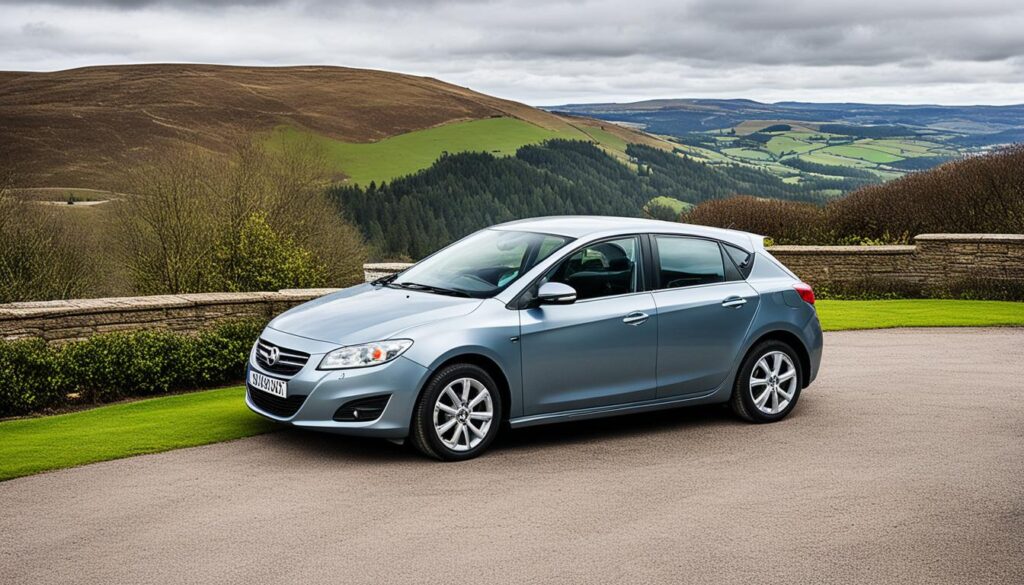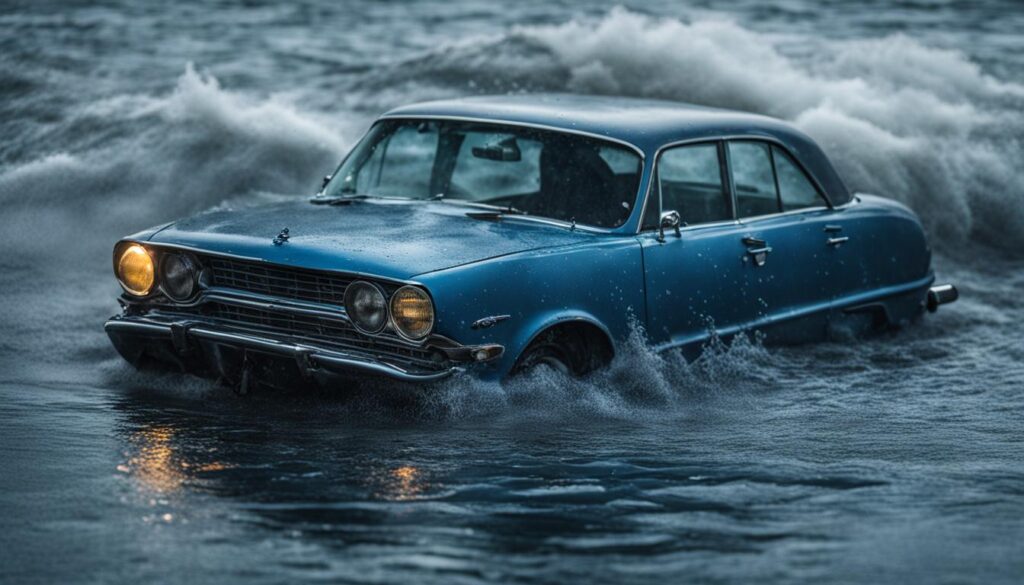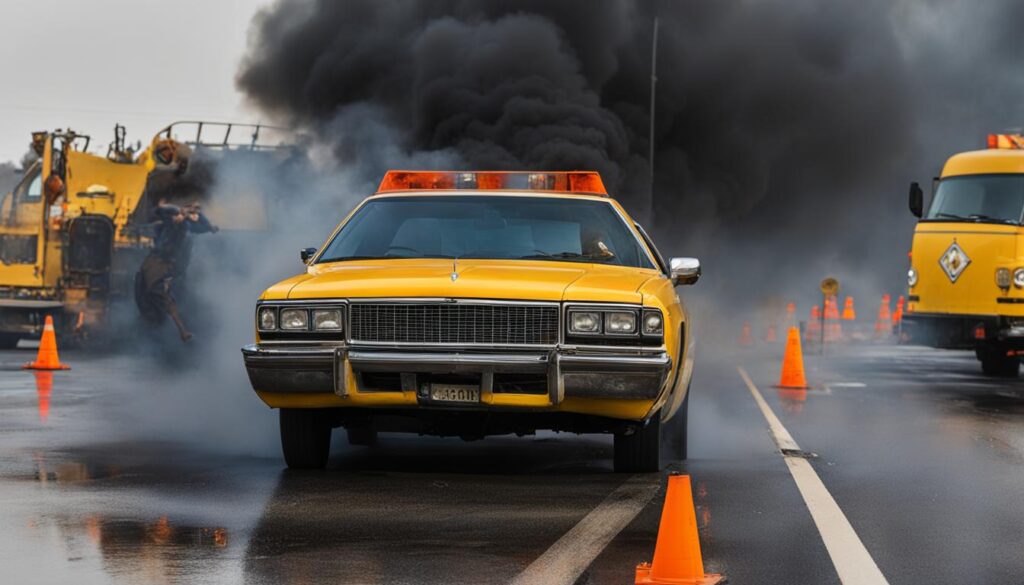Having trouble starting your car? Maybe you’ve noticed odd noises or smoke under the hood? This could mean your starter motor is failing. Recognizing bad starter symptoms and fixing them can save you hassle and money. Let’s explore the signs of starter issues and their solutions together.
Key Takeaways:
- Common symptoms of a bad starter include clicking noise, engine not cranking, and smoke or oil leakage.
- Starter motor problems may come from loose wires, dirty connections, battery corrosion, damaged components, and oil leaks.
- You can troubleshoot by checking the battery, tapping the starter, fixing transmission settings, and seeking a technician’s help.
- It helps to know how the starter motor works with the battery and alternator.
- Regular upkeep and timely fixing of starter issues are key to avoiding more damage.
What is a Starter and How Does it Work?
The starter is basically a small motor. It gets power from the battery to start the engine. By turning the engine crankshaft, it begins the combustion process. A starter relay is like a switch between the battery and the starter motor. It sends power to start the engine. If the starter relay or motor fails, your vehicle won’t start, needing a tow.
To understand a starter’s function, we’ll look closely at its operations. Turning the key or pressing the start button sends a signal to the starter relay. This relay controls power to the starter motor. Once activated, the starter motor spins. It has a pinion gear that works with the engine’s crankshaft. This action starts the engine’s rotation and combustion. Thus, the engine springs to life.
The starter motor and relay are key for the engine to start. They provide the initial power needed.
The starter system relies on several components working together. This includes the battery, starter motor, starter relay, ignition switch, and wiring. Each part is crucial for the engine to start properly.
The Battery: Power Source
The battery is central to the starting system. It supplies power to all key components. It stores chemical energy and converts it into electrical energy. Upon receiving a signal, the starter relay uses the battery’s power to turn the starter motor on, starting the engine.
The Starter Motor: Engine Starter
The starter motor kicks off the engine’s starting. It changes electrical energy from the battery into mechanical energy. This turns the engine’s crankshaft. Consequently, the engine starts its cycle, leading to fuel combustion and ignition.
The Starter Relay: Engaging the Starter Motor
The starter relay serves as a vital link between the battery and starter motor. When you turn the ignition switch or press the start button, it signals the relay. The relay then allows power to flow from the battery to the starter motor. This action starts the engine.
Knowing how the starter, battery, and relay work together helps troubleshoot issues. Problems with the starter motor, battery, or relay can make starting the engine tough. Understanding these parts allows you to find and fix problems more easily.
For more details on starters and how they function, you can visit this source.
Common Signs of a Bad Starter
Several signs may show your vehicle’s starter is failing. If you notice these symptoms, get your starter motor or relay checked professionally.
- Engine Won’t Turn Over: A clear sign of a bad starter is if the engine doesn’t start when you turn the key. You might only hear a clicking noise instead of the engine cranking.
- Unusual Noises: Hearing strange noises like clinking, grinding, or whirring under the hood when starting your car could mean a faulty starter.
- Intermittent Starting Problems: Intermittent starting issues, where the engine doesn’t start right away, point towards a bad starter. You might need several tries before it kicks in.
- Smoke from Under the Hood: Seeing smoke from under the hood is alarming and urgent. It suggests a short circuit or the starter motor overheating.
If you notice these issues, don’t keep trying to start the car. This can worsen the damage. Instead, reach out to a skilled technician. They can pinpoint the problem and fix or replace what’s needed.
What Causes Starter Problems?
Starter problems can come from many sources. Each one can mess up how well the starter works. Knowing these reasons can help fix starter troubles.
1. Loose Wiring
Loose wiring is a common issue. If wires that connect the starter and electrical system get loose, the power might cut off. This means the starter won’t get the electricity it needs to turn the engine on.
2. Dirty or Corroded Connections
Dirty or corroded connections can also cause trouble. Dirt and moisture can build up, increasing resistance. This makes it hard for electrical current to flow, which can stop the starter from working right.
3. Battery Corrosion
**Battery corrosion** is another issue. Corroded battery terminals can break the connection between the battery and starter. This leads to the starter not getting enough power, making the engine hard to start.
4. Damaged or Worn-Out Parts
**Damaged or worn-out parts** inside the starter system are problematic. The starter motor, solenoid, or gears can wear out or get damaged. This can make the starter fail to work as it should.
5. Oil Leaks
Oil leaks can impact starter function. If oil gets on the starter, it can harm the electrical parts. This can lead to a bad electrical connection and potential starter failure.
6. Bad Relay
A **bad relay** can lead to starter problems too. The relay sends power from the battery to the starter motor. If it’s faulty, the necessary power won’t reach the starter, making the engine hard to start.
To fix starter problems, you need to find and solve these issues. Check and tighten loose wires, clean dirty connections, fix battery corrosion, replace bad parts, stop oil leaks, and replace any bad relays. Doing this can make the starter work well again and ensure the engine starts reliably.
How to Diagnose and Troubleshoot Starter Problems
Figuring out and fixing starter issues are key to get your car running well again. Follow some easy steps to find and solve common starter problems.
1. Check the Battery and Battery Cables
First, make sure the car’s battery and cables work right. Look at the battery for leaks, corrosion, or loose parts.
2. Tap the Starter Lightly
If the engine won’t start and everything else looks fine, try tapping the starter gently. Sometimes, starter parts lose touch with each other. Tapping can fix this, making the starter work again.
“A gentle tap can often solve starter issues by reestablishing proper contact between internal components.” – Car Repair Pro
3. Adjust the Transmission to Neutral
If tapping doesn’t help, shift the transmission from “park” to “neutral.” It’s a trick to see if a safety switch issue is stopping the engine from starting. Switching to neutral might get the starter going.
4. Check the Fuel Gauge
Simply checking the fuel gauge can avoid lots of headaches. An almost empty tank can seem like a starter issue. Make sure your car has enough gas before you start troubleshooting the starter more.
If these steps don’t find the problem, you should see a pro. They have the skills to spot and fix tricky starter issues.
Fixing starter problems can be tough. Always stay safe and care for your car. Follow these guidelines and ask for expert help when needed. You’ll be able to tackle starter problems and have your car ready to go.
How to Start a Car with a Bad Starter
Trying to start a car with a bad starter is tough. Yet, there are ways to get your car running again. Whether you are at home or away, these steps will safely and effectively start your car:
Safely Park Your Car
First, park your car safely in a place away from traffic that is well-lit. Make sure the parking brake is on and turn off the ignition.
Tap the Starter Lightly
If your car’s starter seems stuck, a light tap might free it. You can softly tap the starter with a small hammer. Just be sure not to hit it too hard to avoid damage.
Jump-Start Your Car
If tapping doesn’t fix the issue, try jump-starting your car. Park another working car close but not touching yours. Attach jumper cables to both cars’ battery terminals, making sure they match up. Start the working car to charge your battery for a few minutes. Then, attempt to start your car, which should now work.
Use a Working Car to Charge the Battery
If you can’t jump-start or lack cables, use another car to charge your battery. Park it near yours without touching. Open the hoods to access the batteries. Connect a battery charger to the working car’s battery as instructed. Then, attach it to your car’s battery. Charge your car’s battery for a few minutes, then try starting your car.
Note: These methods offer a temporary fix for a car with a bad starter. It’s key to repair or replace the starter soon to prevent other problems.

By following these steps, you can start a car with a bad starter effectively. It’s important to fix or replace the starter for your car’s reliability. If these steps don’t help or you’re unsure, seek help from a professional technician.
The Electric Trifecta – How it Works
The interplay between three parts—battery, alternator, and starter motor—is crucial. They work together for a car to start smoothly and run without stopping.
The battery acts as the power reservoir. Turning the ignition key makes the battery power up the starter motor. This step is vital for starting the combustion process.
The alternator jumps in once the engine runs. By spinning an electromagnet, it produces electricity. This power does two things. It charges the battery for next time. And, it powers the car’s electrical system while driving.
In short, these three components bring a vehicle to life. They keep it functioning and make sure it has enough power.
Components of the Electric Trifecta:
| Component | Description |
|---|---|
| Battery | Stores electricity and supplies power to engage the starter motor. |
| Starter Motor | Turns the engine over, initiating the combustion process. |
| Alternator | Generates electrical power while the engine is running to recharge the battery and power the electrical system. |
Common Causes of Starter, Battery, and Alternator Failure
Various factors can lead to the failure of starters, batteries, and alternators. We will look at some common reasons behind these failures.
Exposure to Water
Water can harm the starter, battery, and alternator. It can remove lubricants, causing more friction and wear. It can also make metal parts rust and break down over time. Besides, electrical connections might short out because of water. Keeping these parts dry is key to avoiding failures.
High or Low Temperatures
Big temperature changes affect the starter, battery, and alternator a lot. When it is very hot, the battery loses power faster. This shortens its life. Too much heat can also cause the starter and alternator to wear out and fail sooner. When it’s cold, batteries don’t work as well, making it harder to start the engine. Taking care of these parts in extreme temperatures is very important.
Improper Installation
How these parts are put in can cause failures. If not installed right, like misaligned starters or tight alternator belts, it puts too much stress on them. This can wear them out quickly. Following the setup guidelines carefully ensures everything runs smoothly. This reduces the risk of failures from wrong installation.
Understanding these common failure causes helps protect your vehicle’s parts. Regular checks, good upkeep, and fixing problems right away can make them last longer. This way, your car’s electrical system stays in top shape.
| Cause | Effect |
|---|---|
| Exposure to water | Washing away lubricants, corroding metal parts, shorting out electrical connections |
| High or low temperatures | Reduced battery capacity and lifespan, accelerated wear and damage to the starter and alternator |
| Improper installation | Premature wear and damage due to poor alignment or over tensioning |

Exposure to water can wash away lubricants, corrode metal parts, and short out electrical connections.
How to Tell If Your Battery, Alternator, or Starter Is Bad
Knowing how to spot issues with your vehicle’s battery, alternator, or starter is key. Watching for certain signs will help you realize which part might be failing. Here are some important signs to watch for:
Slow Engine Cranking
If your engine starts slowly or struggles to start, it could mean trouble. This slow cranking might show that the battery is weak. It might lack the power to get the starter motor going and turning the engine over.
Dim Lights
Noticing dimmer interior and headlights is a clue that something’s off. If the battery, alternator, or starter isn’t working right, power might be lower. This can cause your vehicle’s lights to dim or flicker.
Illuminated Check Battery or Check Engine Light
A lit up check battery or engine light is your car’s way of saying there’s an issue. These lights warn you when there’s a problem with the electrical system. Seeing these lights means you should get your car checked by a pro soon.
Grinding or Squealing Noises
Hearing grinding or squealing noises under the hood is not a good sign. It might mean something is wrong with the starter. These sounds can point to the starter motor failing or another issue in the starter system.
Keeping an eye on these signs helps you spot problems with your battery, alternator, or starter. Dealing with these problems quickly can avoid more damage. It helps make sure your vehicle starts and runs well.
Conclusion
If you have starter motor problems, it’s crucial to fix them quickly. Doing so ensures your car starts smoothly. Checking the battery, lightly tapping the starter, and jump-starting are temporary fixes. But, it’s smart to get a technician to check and possibly replace the starter.
To avoid starter motor issues, regular battery checks are key. A skilled technician should do any starter repairs or replacements. They have the right tools and know-how. This way, the correct fix, like repairing or replacing the starter, is used.
Taking care of your car’s starter motor is essential for good performance and long life. Avoiding starter problems or trying to fix them yourself can cause more damage and costs. Therefore, it’s best to rely on a professional for repairs, replacements, and maintenance.
For tips on spotting a failing Nissan starter motor, visit this helpful resource.




